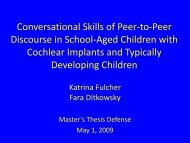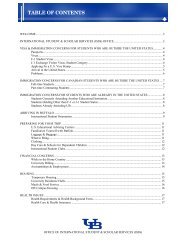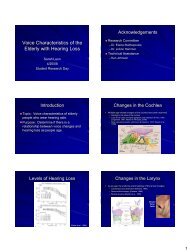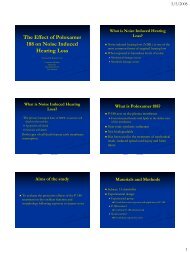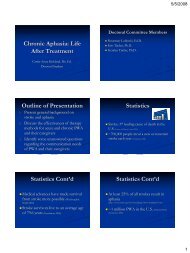Speech Disruptions in the Narratives of English-Speaking Children ...
Speech Disruptions in the Narratives of English-Speaking Children ...
Speech Disruptions in the Narratives of English-Speaking Children ...
You also want an ePaper? Increase the reach of your titles
YUMPU automatically turns print PDFs into web optimized ePapers that Google loves.
Cl<strong>in</strong>ical and Experimental Implications<br />
The current f<strong>in</strong>d<strong>in</strong>gs have two implications for cl<strong>in</strong>icians<br />
and researchers who are <strong>in</strong>terested <strong>in</strong> speech<br />
disruptions <strong>in</strong> special populations. First, <strong>the</strong> measurement<br />
<strong>of</strong> silent pauses shorter than 2,000 ms should be<br />
<strong>in</strong>corporated <strong>in</strong>to language sample analyses. Traditional<br />
transcription conventions (e.g., Miller & Chapman, 2000)<br />
focus only on silent pauses that are equal or greater than<br />
2,000 ms. Our results showed that silent pauses <strong>of</strong> 500 ms<br />
to 1,000 ms, ra<strong>the</strong>r than those greater than 2,000 ms,<br />
dist<strong>in</strong>guished fourth-grade children with SLI from <strong>the</strong>ir<br />
age-matched peers. Second, <strong>the</strong> results from current<br />
and previous studies (Boscolo et al., 2002; Dollaghan &<br />
Campbell, 1990) showed that token frequency <strong>of</strong> disruptions<br />
divided by <strong>the</strong> total number <strong>of</strong> words is a measure<br />
that is sensitive to language impairment. Future<br />
studies exam<strong>in</strong><strong>in</strong>g speech disruption rates <strong>in</strong> special<br />
populations may need to take <strong>the</strong> total number <strong>of</strong> words<br />
<strong>in</strong>to consideration (cf. Rispoli, 2003).<br />
Issues for Future Research<br />
This study did not <strong>in</strong>clude <strong>the</strong> disruption type,<br />
prolongation, <strong>in</strong> <strong>the</strong> analysis. Prolongation <strong>in</strong>volves <strong>the</strong><br />
leng<strong>the</strong>n<strong>in</strong>g <strong>of</strong> word segments or syllables and is determ<strong>in</strong>ed<br />
perceptually relative to <strong>the</strong> speech tempo <strong>of</strong><br />
<strong>the</strong> preced<strong>in</strong>g syllables (Liu, 1998). We did not <strong>in</strong>clude<br />
prolongation <strong>in</strong> <strong>the</strong> analysis because we could not<br />
reliably identify <strong>the</strong> prolongation <strong>of</strong> syllables, especially<br />
phrase-f<strong>in</strong>al syllables. Prolongation, however, tends to<br />
signal <strong>the</strong> process <strong>of</strong> retriev<strong>in</strong>g words or phrases (Liu,<br />
1998). <strong>Children</strong> with SLI appear to have lexical retrieval<br />
difficulties. Exclud<strong>in</strong>g prolongation <strong>in</strong> this study may<br />
have limited <strong>the</strong> opportunity to capture <strong>the</strong> details <strong>of</strong><br />
<strong>the</strong>se difficulties <strong>in</strong> children with SLI. Therefore, we suggest<br />
that future studies <strong>in</strong>clude prolongation <strong>in</strong> <strong>the</strong><br />
analysis and exam<strong>in</strong>e its relation to lexical retrieval<br />
deficits.<br />
This study demonstrates that silent pauses are<br />
sensitive to <strong>the</strong> underly<strong>in</strong>g deficits <strong>of</strong> children with SLI.<br />
The difference between fourth-grade children with SLI<br />
and <strong>the</strong>ir age-matched peers is restricted to silent pauses<br />
<strong>of</strong> 500–1,000 ms. There might, however, be developmental<br />
differences <strong>in</strong> this pattern. For <strong>in</strong>stance, younger<br />
children with SLI may differ from <strong>the</strong>ir age-matched<br />
peers <strong>in</strong> silent pauses <strong>of</strong> 1,000–2,000 ms. This f<strong>in</strong>d<strong>in</strong>g<br />
might also vary by us<strong>in</strong>g different tasks (e.g., conversation,<br />
expository discourse). In addition, we did not f<strong>in</strong>d<br />
that children with and without SLI differed <strong>in</strong> <strong>the</strong> use <strong>of</strong><br />
filled pauses or <strong>in</strong>terjections probably because <strong>of</strong> <strong>the</strong><br />
limitation <strong>of</strong> narrative tasks. Future research should<br />
address potential developmental changes <strong>in</strong> speech disruptions<br />
and should <strong>in</strong>clude different tasks to verify<br />
<strong>the</strong>se issues.<br />
Conclusion<br />
<strong>Speech</strong> disruptions reflect <strong>the</strong> cognitive processes<br />
underly<strong>in</strong>g language production. This study exam<strong>in</strong>ed<br />
<strong>the</strong> types, frequencies, and distribution <strong>of</strong> speech disruptions<br />
<strong>in</strong> <strong>the</strong> narratives <strong>of</strong> fourth-grade children with<br />
SLI and <strong>the</strong>ir age-matched and language-matched<br />
peers. <strong>Children</strong> with SLI produced speech disruptions<br />
more <strong>of</strong>ten than <strong>the</strong>ir age-matched peers but not <strong>the</strong>ir<br />
language-matched peers, suggest<strong>in</strong>g a relationship<br />
between language ability and speech disruption. The difference<br />
between children with SLI and <strong>the</strong>ir age-matched<br />
peers was conf<strong>in</strong>ed to silent pauses <strong>of</strong> 500–1,000 ms.<br />
<strong>Children</strong> with SLI did not produce more disruptions<br />
across <strong>the</strong> board <strong>in</strong> <strong>the</strong> production <strong>of</strong> narratives; ra<strong>the</strong>r,<br />
<strong>the</strong>y outnumbered <strong>the</strong>ir peers <strong>in</strong> disruptions before<br />
phrases but not before sentences, clauses, or words.<br />
Taken toge<strong>the</strong>r, <strong>the</strong>se f<strong>in</strong>d<strong>in</strong>gs suggest that speech disruptions<br />
at phrase boundaries produced by children<br />
with SLI reflect <strong>the</strong>ir underly<strong>in</strong>g lexical and syntactic<br />
immaturity.<br />
Acknowledgments<br />
This study was supported by Grant 1-P50-DC02726 from<br />
<strong>the</strong> National Institute on Deafness and O<strong>the</strong>r Communication<br />
Disorders. We thank Marc Fey for <strong>of</strong>fer<strong>in</strong>g <strong>the</strong> transcriptions<br />
<strong>of</strong> narratives; Rick Arenas, Juanita Limas, Marlea O’Brien,<br />
Chun-yi Shen, Yi-li Yang, and Xuyang Zhang for assist<strong>in</strong>g with<br />
preparation <strong>of</strong> <strong>the</strong> article; Hs<strong>in</strong>-jen Hsu; Amanda J. Owen; <strong>the</strong><br />
Language Development Group; and students <strong>in</strong> <strong>the</strong> scientific<br />
writ<strong>in</strong>g class (Spr<strong>in</strong>g 2006, University <strong>of</strong> Iowa).<br />
References<br />
Abbot-Smith, K., & Tomasello, M. (2006). Exemplar-learn<strong>in</strong>g<br />
and schematization <strong>in</strong> a usage-based account <strong>of</strong> syntactic<br />
acquisition. The L<strong>in</strong>guistic Review, 23, 275–290.<br />
Bernste<strong>in</strong>, N. (1981). Are <strong>the</strong>re constra<strong>in</strong>ts on childhood<br />
disfluency Journal <strong>of</strong> Fluency Disorders, 6, 341–350.<br />
Bloodste<strong>in</strong>, O., & Grossman, M. (1981). Early stutter<strong>in</strong>gs:<br />
Some aspects <strong>of</strong> <strong>the</strong>ir form and distribution. Journal <strong>of</strong><br />
<strong>Speech</strong> and Hear<strong>in</strong>g Research, 24, 298–302.<br />
Bock, K., & Levelt, W. (1994). Language production: Grammatical<br />
encod<strong>in</strong>g. In M. Gernsbacher (Ed.), Handbook <strong>of</strong><br />
psychol<strong>in</strong>guistics (pp. 945–984). San Diego: Academic Press.<br />
Boomer, D. (1965). Hesitation and grammatical encod<strong>in</strong>g.<br />
Language and <strong>Speech</strong>, 15, 103–113.<br />
Boscolo, B., Bernste<strong>in</strong> Ratner, N., & Rescorla, L. (2002).<br />
Fluency <strong>of</strong> school-aged children with a history <strong>of</strong> specific<br />
expressive language impairment: An exploratory study.<br />
American Journal <strong>of</strong> <strong>Speech</strong>-Language Pathology, 11, 41–49.<br />
Chang, F., Dell, G., & Bock, K. (2006). Becom<strong>in</strong>g syntactic.<br />
Psychological Review, 113, 234–272.<br />
Clark, H. H. (2002). Speak<strong>in</strong>g <strong>in</strong> time. <strong>Speech</strong> Communication,<br />
36, 5–13.<br />
Downloaded from jslhr.asha.org on November 10, 2010<br />
Guo et al.: <strong>Speech</strong> <strong>Disruptions</strong> <strong>in</strong> SLI <strong>Narratives</strong> 735



